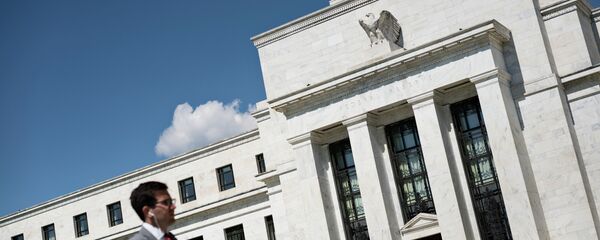Kristian Rouz — US Department of Commerce released a revised figure for the pace of economic expansion in the first quarter, up to an annualized 0.8% from 0.5% reported previously. Quicker increases in disposable incomes and savings rates pushed over all GDP gains, the revised report said. Damage to the US economy from international trade headwinds and negative dynamics in inventories turned out to be less significant than previously thought, providing a slightly brighter outlook into 2Q16.
American GDP added 0.8% year-on-year in January through March period, the Commerce Department reported on Friday. This is an upward revision on the advance estimate at 0.5% published previously, yet, the slowdown in the US economy at the year's start still looks dramatic, as declines in corporate profits and manufacturing were the major downside factor. The revised figures only suggest a better outlook for the US consumption, whilst most macro fundamentals remain sluggish.
In 4Q15, US GDP added an annualized 1.4%.
"This gives us more confidence that growth will hit its marks in the second quarter <…> enough forward speed for the Fed to continue with its gradual pace of rate hikes," Chris Rupkey of New York-based MUFG Union Bank said.
The Federal Reserve, meanwhile, somewhat eased market concerns of an allegedly looming fund rates hike in June, as the Fed Chair Janet Yellen only noted on Friday a raise in rates would happen within "months," possibly suggesting a July hike, which would be a more appropriate moment in time. A June hike perspective is marred somewhat by a possible Brexit and entailing risks unraveling just a week after the Federal Open Market Committee (FOMC) meeting in June, whilst a hike in September is unlikely during the higher market volatility at the height of the US election campaign the autumn.
"The economy is continuing to improve <…> growth looks to be picking up," Yellen said in remarks in Boston. "If that continues and if the labor market continues to improve, and I expect those things to occur <…> in the coming months such a move would be appropriate."
Considering all the risks, it would be most prudent to expect hikes in US borrowing costs in July and, unless the economy slides into a recession before then, in December.
US consumption, driving over 70% of GDP expansion, meanwhile, gained 1.9% in the first quarter, in line with previous estimates.
Yellen's remarks of the looming raise in borrowing costs resulted in the markets now expecting a July hike over that in either June or September, according to dynamics in stocks and bonds markets in Friday's trading. Stocks rolled back on Wall Street, signaling investors' are not expecting a June hike as much as they were prior to Yellen's remarks.
Meanwhile, US Treasuries yield curve flattened further, reflecting higher recession expectations. Therefore, the most likely scenario is a hike in fund rates in July, and a subsequent recession hitting in late 2016, effectively limiting the number of hikes to just one this year.





